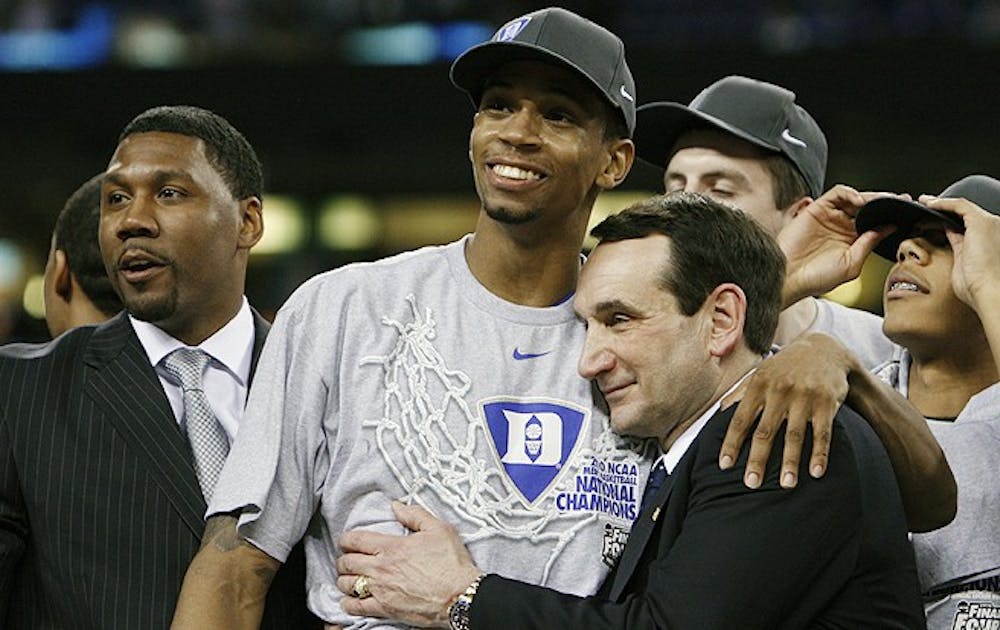Well, that ended quickly.
For almost two weeks, it appeared Lance Thomas and his accessories were poised to become the litmus test for NCAA equality—could Duke, the longtime paragon of academic and athletic excellence, truly be subject to major punishment for rules violations?
Nope.
And the NCAA might be the happiest to see it end this way.
Sure, the NCAA says it will still go through with an investigation. It’ll make some phone calls, hear some “no comments” and then let it disappear as another issue makes national headlines.
It really doesn’t have another option. The only people who have firsthand knowledge of what happened inside Rafaello & Co.—most notably why the company offered a 21-year-old with a full-time volunteer job $67,800 worth of credit to be paid within 15 days—are Thomas and the firm itself, and both have stonewalled all interview requests by the media and the NCAA since the settlement, which included a confidentiality agreement.
(A brief aside: No hard evidence has yet been presented to suggest Thomas actually took an extra benefit beyond a series of crude analyses of his immediate family’s socio-economic status by various media nationwide. The bottom line is nobody has any idea what happened outside of Thomas and the jeweler, and it’s silly to pretend that we do. For the purposes of this particular column, all that matters is the NCAA’s inability—or reluctance—to respond to this type of situation.)
The NCAA relies almost completely on three major sources for its investigations: whistleblowing (see Bush, Reggie), self-reporting and incidental exposure (like Thomas’ case). The problems presented by relying on third parties for information are obvious. Whistleblowers almost always have an ulterior motive in coming forward, often a grudge against the player or institution in question. Nobody ever self-reports a major violation unless damning evidence has already presented itself, and the athletic department thinks it can ease the punishment through honesty, however late it may be. When violations appear as a secondary result of a court case, though, as in Thomas’ situation, the parties involved can make it disappear all too easily, leaving the NCAA stuck thumping its rulebook indignantly.
In fairness, the NCAA could not possibly employ enough staff to monitor each of its member institutions closely, nor would that be a prudent solution. Its massively overwrought rulebook needs an overhaul, though, if only so the organization can establish a clear and consistent set of guidelines enforceable across the country that everyone from athletes to coaches to fans can understand—not just NCAA compliance officers.
Otherwise, the accusations of selective enforcement, which will follow the Thomas case whether or not it merits the claim, will plague the organization forever.
Those accusations already follow the Blue Devils. In 2009, Corey Maggette testified before a grand jury that he had received cash payments of about $2,000 from a summer league coach while he was in high school, leading Duke’s Executive Vice President Tallman Trask III to say the admission “raises substantial questions about his eligibility to play for the Blue Devils during the 1998-99 season” in an official statement.
Maggette and Duke were eventually cleared because the NCAA concluded that “there was insufficient evidence to determine Maggette knew or should have known” that he was ineligible because of the high school payments, according to NCAA Vice President of Enforcement David Price.
Huh?
If that doesn’t say enough about the confounding nature of NCAA compliance, nothing does. Amateurism is the most basic of the NCAA’s rules, presumably, so if an athlete doesn’t understand how taking money constitutes a violation of that principle, something has gone horribly wrong.
So why not trim the guidelines down to size with simplicity in mind? It’s true that simplicity means generalization, which could lead to more loopholes for rule breakers to exploit—part of the reason why the current rulebook is so dense (at least it finally allows schools to give athletes cream cheese with their bagels, a no-no until the Big East crusaded for the rule’s repeal last summer). But if the code of bylaws is too much for anyone but a compliance officer to understand, following all the rules down to the letter becomes impossible.
Trim it down. Keep allowing more cream cheese with the bagels. Make it clear that taking money from coaches or agents is a major no-no. But do it so I don’t have to take the rulebook down to Duke Law for interpretation.
Get The Chronicle straight to your inbox
Signup for our weekly newsletter. Cancel at any time.

